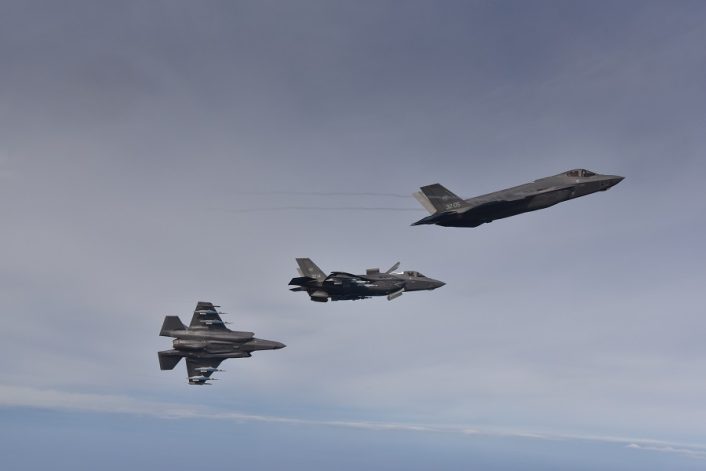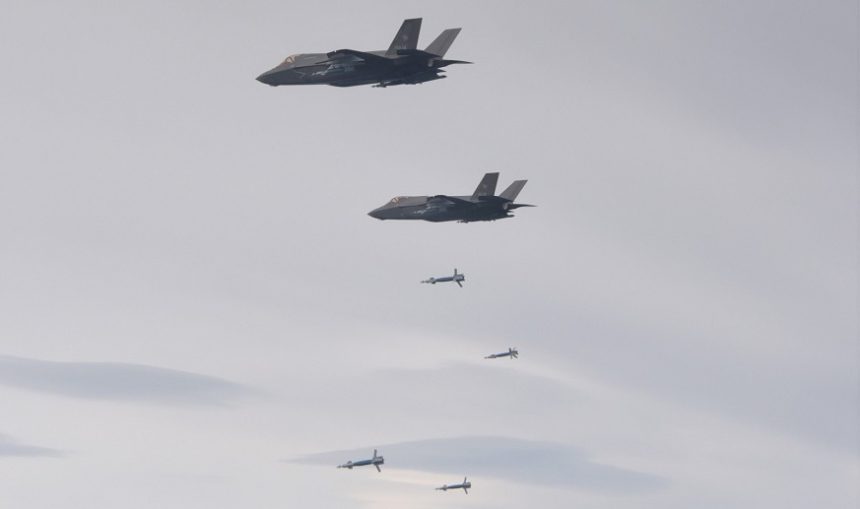For the very first time, the Italian Air Force F-35A and F-35B carried out a simultaneous drop of GBU-12 LGBs.
On Jan. 28, 2021, the Italian Air Force two F-35A and one F-35B assigned to the 32° Stormo (Wing) based at Amendola Air Base, deployed to Decimomannu Air Base, Sardinia, home of the RSSTA/AWTI (Reparto Sperimentale e di Standardizzazione Tiro Aereo/Air Weapons Training Installation) of the Italian Air Force, have conducted a mission that involved the use of inert weapons on the PISQ (Poligono Interforze Salto di Quirra – Salto di Quirra Joint Range), an EW (Electronic Warfare) range located in central eastern Sardinia, just a few minutes flight time distance from “Deci”.
The mission, flown in so-called “Beast Mode”, was carried out as part of the OT&E (Operational Test and Evaluation) of the 5th generation weapon system, and allowed to test the simultaneous drop of LGBs (Laser Guided Bombs) from the F-35A and F-35B, and marked the very first time the Italian STOVL (Short Take Off Vertical Landing) variant of the Lightning II aircraft dropped a GBU-12.
The activity involved personnel from both the 32° Stormo and the Reparto Sperimentale Volo (the Italian Air Force Test Wing) and was carried out during the deployment to Decimomannu of the 13° Gruppo (Squadron) of the 32nd Wing, so as to assess the ability of the unit to operate in “Split Ops”, with aircraft and personnel generating sorties both at the MOB (Main Operating Base) and the DOB (Deployment Operating Base).
The Aeronautica Militare (Italian Air Force) released the first photos of the F-35A and B during training mission in “Beast Mode”, with internal and external weapons for the very first time in November 2020. The F-35A carried four GBU-12s LGBs (Laser Guided Bombs) on the external pylons and two AIM-120 AMRAAM air-to-air missiles in the weapons bay; the F-35B, airframe serialled MM7453/32-14, flying in STOVL (Short Take Off Vertical Landing) mode, carried four GBU-12s. As we explained back then, that was this the first time the aircraft flew in “Beast Mode” as well as the first time the Italian F-35s were photographed with external loads.
As already explained in details, “Beast Mode” is not an official or technical term, but it has become a pretty common way an F-35 configuration involving both internal and external loads has been dubbed. […] As opposed to a “First Day of War” loadout, in which the F-35 would carry weapons internally to maintain low radar cross-section and observability, the “Third Day of War” configuration is expected to be used from the third day of an air campaign when, theoretically, enemy air defense assets (including sensors, air defense missile and gun systems and enemy aircraft) have been degraded by airstrikes (conducted also by F-35s in “Stealth Mode”) and the battlespace has become more permissive: in such a scenario the F-35 no longer relies on Low-Observability for survivability so it can shift to carrying large external loads. These conditions are not always met. For instance, LO was not needed when the F-35A was called to carry out the first air strike in the Middle East, nor when the U.S. Marine Corps F-35B carried out the first air strike in Afghanistan.
According to the latest plans, Italy is procuring 90 F-35s: 60 F-35As and 30 F-35Bs. Out of those 30 F-35Bs, 15 will go to the Navy and 15 to the Air Force.

The Italian Air Force considers the F-35B and its STOVL capability a crucial component of a larger expeditionary system that makes the Air Force capable to project power. Here’s what the ItAF Chief of Staff, Gen. Alberto Rosso, said during the presentation of the F-35B at Pantelleria in July last year:
“This capability is extremely important to face new scenarios or situations like the one we had during the Gulf War. Our Tornado jets were deployed to an airbase [Al Dhafra Air Base, UAE] that was far away from the area of operations: this implied that our aircraft had to fly several hours and carry out several aerial refuelings before reaching their targets.
The ability to operate from shorter runways can allow the selection of a closer airbase and solve the problem. In terms of flexibility, just think that in Africa there are about 100 runways that have a length between 2,800 and 3,000 meters but there are 20 times as many runways between 1,000 and 1,500 meters in length. Being able to use short runways allows you to multiply your ability to deploy where needed, in a more convenient and faster way, especially closer to the area of operation. Having an aircraft that is capable of taking off from shorter runways allows incredible flexibility even in those scenarios that are currently only barely conceivable. In case of conflict, aircraft that are able to operate from shorter runways can also be dispersed to increase their survivability.
This flexibility to operate from bare/austere runways or even highways makes the air power more unpredictable and represents a fundamental capability in any scenario. For this reason, after carefully studying all the scenarios and costs, the Italian Air Force has identified, as done by other air arms, a mixed fleet of F-35A and B aircraft, as the most economically convenient and effective configuration.”
Dealing with the Italian Navy, the Cavour aircraft carrier is about to start qualification with the new F-35B, the STOVL variant, of the Lightning II jet. The flagship of the Marina Militare (Italian Navy) is set to reach Naval Station Norfolk in mid-February to start F-35B qualifications with the U.S. Marine Corps. After becoming an aircraft carrier qualified with the 5th generation STOVL aircraft, one of the steps required to achieve the IOC (Initial Operational Capability) of the aircraft carrier with the new jet, the 27,000-ton ship will set sail back to Italy, where the aircraft carrier will embark an Italian Navy F-35B, the third to be delivered to the Italian naval service: the first two F-35B jets, assembled at the Italian FACO (Final Assembly and Check Out) in Cameri were handed over to the Marina Militare in 2018 and 2019. These were then transferred to MCAS Beaufort, home of the U.S. Marine Corps F-35B pilot training.









